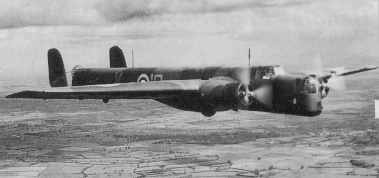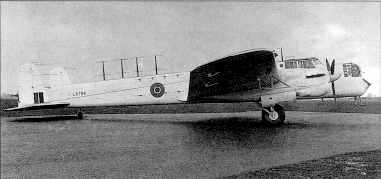Fighting the U-boats
Aircraft & Air forces
Armstrong Whitworth Whitley
prepared by Emmanuel Gustin

Armstrong Whitworth Whitley Mk.1 bomber
The Armstrong Whitworth A.W.38 Whitley was designed to specification B.3/34 for a heavy night bomber. The Whitley was a curious mix of the new and the old. It was a all-metal stressed-skin monoplane with retractable landing gear. But its wing was characteristic of older designs: Large, very thick, and set at a high angle of incidence to keep landing speed low. This resulted in a marked nose-down attitude in level flight. The fuselage was long and box-like, with flat sides, but narrow. Gun turrets were installed in the nose and the tail. A bomb-aiming station was under the nose turret. The low-set tailplane carried two fins, attached to the tailplane at half-span and strut-braced. Two bomb bays were in the fuselage; more bombs could be carried in the thick wing.
The pedestrian nature of the Whitley's design becomes obvious when one compares it with the Dornier Do 17, which flew in 1934, with the Lockheed model 10 Electra, or with the Bristol Blenheim, which flew one month later than the Whitley. Performance was unspectacular and controls were heavy. However, take-off and landing were easy, a feature that was important for night operations, and the Whitley was sturdy.
The Whitley was ordered "off the drawing board" in August 1935, because the RAF urgently needed something to replace the Handley Page Heyford and Fairey Hendon. The first flight of a Whitley was made on 17 March 1937. Delivery of production aircraft began in the beginning of the following year, and by March No.10 squadron began to receive its aircraft. These were Mk.Is, powered by 795hp Armstrong Siddeley Tiger IX radial engines, and armed only with a single Vickers K gun in both nose and tail turret. It was followed by the Mk.II, with 920hp Tiger VIII engines and dihedral on the outer wing panels. On the Mk.III a retractable ventral turret was added, and the bomb racks were modified, so that heavier bombs could be loaded.
 A Whitley GR Mk.VII. The Tiger radials of the Mk.I have been replaced by Merlin engines. Note also the presence of radar dipoles on the fuselage, under the nose and under the wings
A Whitley GR Mk.VII. The Tiger radials of the Mk.I have been replaced by Merlin engines. Note also the presence of radar dipoles on the fuselage, under the nose and under the wings
In August 1939 deliveries switched to the much better Mk.IV, with Rolls-Royce Merlin engines (the 1030hp Merlin IV, or the 1145hp Merlin X on the Mk.IVA) and a powered two-gun tail gun turret. The definitive bomber model was the Mk.V. This model had a slightly longer nose, tailfins with straight instead of rounded edges, wing de-icing equipment, constant-speed propellers, a Fraser-Nash tail turret with four .303 Brownings, and more fuel. Of the total production of 1737, 1466 where Mk.Vs. Production of the Mk.V ended in June 1943.
When war broke out, Bomber Command had six Whitley squadrons, in No.4 Group. On 3 September, they took off to drop leaflets over Germany. At that time, there was great reluctance to bomb possible civilian targets, also because of fear of German counter-attacks. These missions encountered little opposition, but failed to generate any enthusiasm in Bomber Command crews. Even the propaganda value of the early, crude leaflets was poor. On 19 March 1940, Whitleys dropped bombs in anger. The target was the seaplane base on the island Sylt. Unfortunately, the bombers hit the neutral Danish island Bornholm! The Whitley was making the way for the offensive of Bomber Command, gaining valuable experience --- and one lesson was that navigation over enemy territory at night was very difficult.
From April 1942, the Whitley was retired as first-line bomber. It continued to serve as glider tug, paratroop trainer, transport, or radio countermeasures aircraft. It also played an important role in Coastal Command. That association had begun in September 1939, when No.58 squadron, with its standard bombers, was transferred to meet the desperate need for a more effective aircraft than the Avro Anson. In the autumn of 1940 more Whitleys became available.
But it was late in 1941 before the Whitley GR Mk.VII appeared, a dedicated patrol aircraft. It carried more fuel, but the big change was the installation of ASV Mk.II radar. The Whitley with its long slab-sided fuselage was ideal for the dipole arrays of Long-Range ASV, which were installed on the sides and on top of the fuselage. The first experimental LRASV installation had actually been made on a Whitley, J-DY, late in 1939. With a navigator and a radar operator added, the crew was increased to six. 146 Mk.VIIs were built, and they equipped four squadrons of Coastal Command.
In November 1941 a Whitley sank U-206 in the Bay of Biscay, after codebreakers had revealed the submarine's approximate position. It was the first success of ASV Mk.II. But even in Coastal Command the Whitley was quickly overshadowed by more capable aircraft.
U-boats sunk by this aircraft type (Whitley)
Specifications
Whitley B Mk.V
Night bomber
Crew of four
Two 1145hp Rolls-Royce Merlin X engines
Wing span, 25.6m, length 21.5m, height 4.57m.
Empty weight 8768kg, max take-off weight 15196kg.
Maximum speed 357km/h, cruising about 297km/h.
Service ceiling
Range 2650km with 1360kg, 756km with 3175kg.
Armament: One .303 Vickers K gun in the nose turret, four .303 Browning guns in the tail turret, up to 3175kg of bombs.


